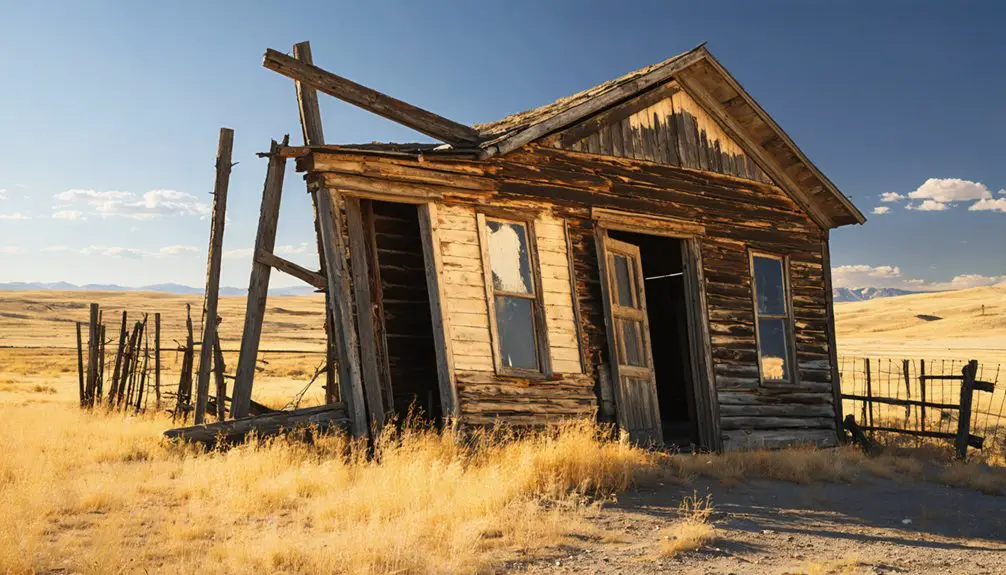You’ll find Dana, Wyoming’s remains 150 miles west of Cheyenne, where this short-lived coal mining settlement operated from 1888 to 1891. As Wyoming’s first Black-majority mining town, Dana played an essential role in labor rights history when nearly 200 Black miners joined forces with European workers to fight for fair wages and safer conditions. Though the town’s structures have vanished, its legacy lives on in Wyoming’s labor laws and cultural heritage.
Key Takeaways
- Dana was a short-lived coal mining settlement established by Union Pacific Railway, operating for only three years from 1888 to 1891.
- The town became Wyoming’s first Black-majority mining community when African American miners arrived from Ohio in 1890.
- Poor coal quality and economic challenges led to Dana’s abandonment, with all physical structures now completely vanished.
- Dana’s miners fought for labor rights and fair wages, leading to significant reforms in Wyoming’s coal industry.
- The ghost town’s location was approximately 150 miles west of Cheyenne along the Union Pacific Railroad’s Overland Route.
The Rise of a Coal Mining Settlement
When the Union Pacific Railway established a stage stop about 150 miles west of Cheyenne, they couldn’t have known it would transform into Dana, one of Wyoming Territory’s most unique coal mining settlements.
Between 1888 and 1891, the Union Pacific Coal Company turned this simple rest stop into a bustling coal camp. Workers from nearby Carbon braved the harsh winter of 1888 to build the mine entrance and set up processing equipment, marking the beginning of dramatic community dynamics. The mine’s development occurred despite the company’s awareness of poor coal quality. Their aggressive recruitment tactics resulted in diverse ethnic communities living and working together.
You’ll find it fascinating that Dana became Wyoming’s first coal town to actively recruit Black miners, making it the only such settlement with a Black majority population. By early 1890, nearly 200 Black miners and their families had arrived from Ohio, forever changing the social fabric of this frontier outpost despite the mining challenges ahead.
Black Miners Shape Wyoming History
As the first Black miners from Ohio stepped off the train in early 1890, they unknowingly sparked a transformation in Wyoming’s coal industry that would influence labor rights for generations.
Led by Shepperson, this Black migration of 200 workers and their families made Dana one of only two Wyoming towns with a Black majority. The company ensured workers lived in integrated neighborhoods to prevent union organizing.
The miners faced a difficult situation when they discovered they were brought in as intended strikebreakers, but they stood in solidarity with unionized workers instead.
You’ll find their impact resonated through:
- Fighting for fair wages and coal weighing practices that shaped new labor laws
- Building thriving communities that spread to Hanna and Rock Springs after Dana’s closure
- Demonstrating powerful labor activism despite being initially recruited as strikebreakers
Though UPCC tried to suppress their story, these miners’ legacy lives on through their descendants and recent historical recognition of their contributions to Wyoming’s coal mining heritage.
Life in a Union Pacific Company Town
Beyond the racial dynamics that shaped Dana’s early years, life in this Union Pacific company town mirrored the strict control and structure found across the railroad’s network of settlements.
You’d find your entire existence controlled by UP – from the house you lived in to the store where you bought groceries. The community dynamics centered around diverse immigrant experiences, as European workers from Italy, Russia, Poland, and other nations built lives alongside one another despite cultural differences. After the Knights of Labor strike, the railroad turned to hiring Chinese laborers to maintain operations. The town thrived with a mix of businesses including saloons and gambling rooms that entertained workers during its peak years.
Your sons might’ve left school early to work the mines, while your family found comfort in the town’s church, band performances, or social gatherings.
Though UP’s grip was tight, residents created close-knit support networks, sharing traditions and helping neighbors through the isolation and demanding work conditions.
Mining Operations and Economic Realities
You’ll find that Dana’s brief three-year existence stemmed directly from Union Pacific Coal Company‘s poor assessment of its coal seams’ quality.
Despite UPCC’s aggressive mining strategy to offset industry-wide losses from the Panic of 1884, Dana’s inferior coal couldn’t sustain profitability.
The company’s rush to exploit every seemingly viable deposit led them to establish short-lived mining towns like Dana, where economic realities quickly overshadowed initial optimism. The region’s coal mining industry would later support 372 mining fatalities during its operational history.
Coal Quality Issues
The Union Pacific Coal Company faced a stark reality upon opening Dana’s coal mine in 1888: the coal’s inferior quality would ultimately seal the town’s fate.
Despite public optimism, they knew their coal couldn’t compete with higher-grade deposits in the region. Mining inefficiencies mounted as workers struggled to extract value from poor seams. The company attempted to offset losses by bringing in black strike breakers from Ohio.
You’ll find these harsh realities reflected in Dana’s daily operations:
- Miners earned less because screened coal yielded lower measurable tonnage.
- The tipple struggled to process subpar coal, slowing production.
- Workers had to mine marginal seams just to maintain output.
These quality issues sparked labor disputes, with miners demanding fair pay for their difficult work.
UPCC Financial Strategy
While UPCC sought to maintain profitable operations at Dana, market forces severely constrained their options after the Panic of 1884.
You’ll find their financial challenges led them to mine even marginal coal seams that wouldn’t have been touched in better times. They’d cut corners where they could, including controversial practices like coal screening that reduced miners’ pay. The company managed to produce 133,283 tons of coal in their first year of operations at No. 1 Mine.
When strikes threatened production, UPCC’s recruitment tactics shifted dramatically. They hired James E. Shepperson in 1889 to bring in Black miners as strikebreakers, though these workers weren’t told their true purpose.
It’s a telling example of how the company tried to maintain profitability through labor manipulation rather than addressing the underlying issues of poor coal quality and market conditions.
Labor Rights and Worker Struggles

As winter descended on Dana in 1888, labor tensions began brewing at the newly opened Union Pacific Coal Company mine, where workers faced dangerous conditions and unfair pay practices.
You’d find miners joining labor unions like the Knights of Labor to fight against pay disparities, particularly the company’s manipulative coal weighing methods that cheated them of fair wages.
When strikes erupted in 1889, you would’ve witnessed:
- The arrival of 200 Black miners from Ohio, unknowingly recruited as strikebreakers
- James E. Shepperson’s skilled recruitment efforts reshaping the town’s racial dynamics
- Workers uniting across racial lines to demand fair weighing practices
These struggles led to landmark legislation regulating coal weighing and miner safety, proving that Dana’s brief existence left an indelible mark on Wyoming’s labor rights history.
The Legacy of a Lost Community
Though Dana’s physical structures have vanished, you’ll find its remarkable legacy in Wyoming’s labor history through the stories of Black miners who fought for fair wages and working conditions.
The Union Pacific line brought Dana into existence as a bustling coal town, marking the beginning of its short but impactful history.
You can trace the impact of Dana’s workers through their descendants who settled in Rock Springs and Hanna, establishing vibrant Black communities that persisted well into the 20th century.
When you explore Dana’s brief but significant chapter in Wyoming’s mining history, you’re uncovering a pioneering Black community that shaped both the state’s cultural landscape and its labor rights movement.
Workers’ Stories Live On
Despite Dana’s brief three-year existence, the legacy of its Black miners lives on through their profound impact on Wyoming’s labor rights and community development.
Their community resilience shone through as they fought for fair wages and safe working conditions, setting precedents that would shape labor laws across the state.
When you trace the footsteps of these pioneering workers, you’ll find their labor activism rippled through generations:
- They successfully pushed for transparent coal weighing standards, transforming how miners got paid.
- Their tight-knit community spawned new Black neighborhoods in Hanna and Rock Springs.
- Their descendants carried their spirit of resistance to Denver during the great coal migration of the 1940s.
Even as Dana faded into Wyoming’s ghost town history, its workers’ determination never did.
Black Miners’ Enduring Impact
While Dana’s physical structures have long since vanished, the town’s Black miners left an indelible mark on Wyoming’s social and labor landscape. These pioneers demonstrated remarkable Black resilience by refusing to be used as strikebreakers, instead standing united with white miners to demand fair wages and accurate coal weighing practices. Their activism directly shaped Wyoming’s mining legislation and labor rights.
Though the mine’s closure in 1891 scattered Dana’s residents, their cultural legacy flourished in nearby towns like Hanna and Rock Springs. You’ll find their influence in the churches, businesses, and communities they built throughout Wyoming’s coal country.
Despite Union Pacific’s attempts to erase their story, the determination of Dana’s Black miners continues to inspire modern discussions about labor rights and racial solidarity.
Town’s Historical Mining Significance
The story of Dana begins at a modest stage stop along the Overland Route, where Union Pacific Railway tracks stretched 150 miles west of Cheyenne. This brief-lived coal town made history as Wyoming’s first Black-majority mining community, marking a unique chapter in the state’s development.
When you visit Dana’s site today, you’ll find little evidence of the bustling mining operation that once stood there.
Yet in 1888-1891, you would’ve seen:
- A complete mining infrastructure with coal processing equipment and tipples
- Essential community buildings including boardinghouses and a company store
- Nearly 200 Black miners working the coal seams under James E. Shepperson’s leadership
Though Dana’s coal proved inferior and operations lasted only three years, the town’s significance as a pioneering Black community and its role in Wyoming’s labor reforms can’t be understated.
Frequently Asked Questions
What Happened to Dana’s Buildings and Structures After the Town Was Abandoned?
You won’t find many abandoned structures today since there wasn’t much historical preservation after 1891. Most buildings disappeared quickly, leaving only foundations and minor traces on the landscape near Hanna.
Were There Any Schools or Churches Established During Dana’s Brief Existence?
You won’t find records of schools or churches established during the town’s fleeting three-year existence – miners likely relied on informal gatherings and nearby communities for education and worship.
What Was the Average Wage for Black Miners in Dana?
You won’t find exact wage figures, but records show significant wage disparities affected Black miners’ earnings through unfair coal weighing practices, leading to labor disputes over miner conditions and pay equity.
Did Any Descendants of Dana’s Original Black Miners Remain in Wyoming?
You’ll find descendant stories showing some Black miners’ families stayed in Wyoming coal towns like Hanna and Rock Springs through the 1940s, preserving their cultural heritage before economic changes sparked widespread outward migration.
What Natural Landmarks or Geographical Features Surrounded the Town of Dana?
You’ll find rugged high plains terrain, forested patches, and grasslands around Dana Common. The geological formations supported coal mining, while surrounding wildlife adapted to the elevated Wyoming landscape.
References
- https://www.blackpast.org/african-american-history/dana-wyoming-a-black-town-in-the-coal-mining-west/
- https://www.wyohistory.org/encyclopedia/forgotten-town-dana-wyo-story-black-legacy-and-miners-rights
- https://www.motherjones.com/environment/2021/02/the-forgotten-history-of-wyomings-black-miners/
- https://sites.rootsweb.com/~wytttp/ghosttowns.htm
- https://www.wyohistory.org/encyclopedia/most-dangerous-occupation-quest-safety-wyomings-coal-mines
- https://www.hannahistory.com/african-americans-in-the-hanna-basin-history.html?view=full
- https://www.hannahistory.com/hanna-happenings.html
- https://www.hcn.org/issues/53-2/north-people-places-how-wyomings-black-coal-miners-shaped-their-own-history/
- https://www.wyohistory.org/encyclopedia/wyomings-first-coal-bust
- https://www.wyohistory.org/encyclopedia/coal-business-wyoming



